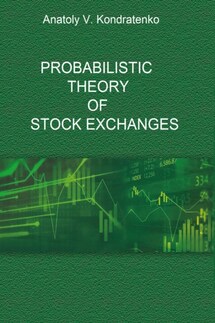Probabilistic Theory of Stock Exchanges - страница 7
Returning to the beginning of the discussion, let us note that the probabilistic economics we developed was also empirical or heuristic in content, based on our twenty-five years of entrepreneurial experience in the investment business. So, in this respect it is no better than any other economic theory; thus, it is virtually unknown in the scientific economic community. But there is an important nuance. Unlike all other theories, probabilistic economics has a developed mathematical body suitable for calculation of any market economic systems. The results of these calculations can be compared with known experimental data, for example for exchanges. In this regard, in this study we have set a goal to find experimental evidence that the very foundations of probabilistic economics are valid, in other words, to verify the initial premises and assumptions of the theory by means of experiments. Moreover, this should be done the way it is done in physics, namely by continuously comparing the results of ab initio calculations of the dynamics of exchange systems and the results of experiment, as well as by subsequently confirming or rejecting the assumptions made. Only this approach, or method of investigation, which we call the physical method in economic science and which is universally recognized in the natural sciences, will make it possible to develop an adequate economic theory capable of giving a sufficiently accurate quantitative description of how real markets of any complexity work, as well as of making sufficiently reliable forecasts of markets and economies development, at least in the short term. In other words, we aim thereby to establish sufficiently accurate experimental justifications for economic science.
Statement two. Let’s recall the great importance of the long-term observations of the solar system planets behavior [Smith, 2016] in the development of modern physics and what John von Neumann said (see above). Richard Feynman was of the same opinion: "Astronomy is older than physics. In fact, physics emerged from it when astronomy noticed the striking simplicity of stars and planets motion; the explanation of this simplicity was the beginning of physics.” Figuratively speaking, the solar system played the role of the first experimental physical laboratory in the history of science. Of course, it was impossible to perform experiments on it in the modern sense of the word, but it was possible to observe the motion of the planets without interference for a long time, and based on these observations the scientists could try to find the rules governing this motion, and even calculate the trajectories of the planets, which was actually done [Feynman et al., 1978; Smith, 2016]. Fortunately, this movement was frequent enough, almost exactly the same, that it allowed us to observe the same phenomena for quite a long time. And the strict periodicity in the planets motion clearly indicated the existence of strict rules governing this motion. It was just a matter of discovering them.
What about economics? Fortunately, we have at our disposal a wonderful experimental economic laboratory that has the potential to brilliantly play the same role in economics that the solar system has played in physics. These are, of course, the exchanges that determine the market prices of goods, services and, especially important in today's economic world, financial assets of various kinds. Physically speaking, exchanges measure prices at each moment of trading, which are unconditionally accepted by the economic community as market prices, i.e., as valid and fair. By measuring market prices and making them universally available, exchanges play an enormous role in modern economic life, providing everyone with a basis for making crucial economic decisions. Despite the important role of exchanges in the real economy, the importance of exchanges in economic theory is far from significant for the reason that a sufficiently developed theory of the exchange capable of adequately describing the dynamics of exchange prices in real time is not available in literature, as far as we know (see, for example, reviews in [Ippoliti and Cheng, 2017]). It is our purpose in this paper to develop such a dynamic economic theory, and fulfillment of such purpose, among other things, will help to confirm (or refute) the foundations of probabilistic economic theory, which is of particular interest to us. Looking ahead, we note that here, we also found the same "striking simplicity of movement" of market agents, despite the fact that the exchange, without any doubt, is a complex dynamic nonequilibrium probabilistic system.







